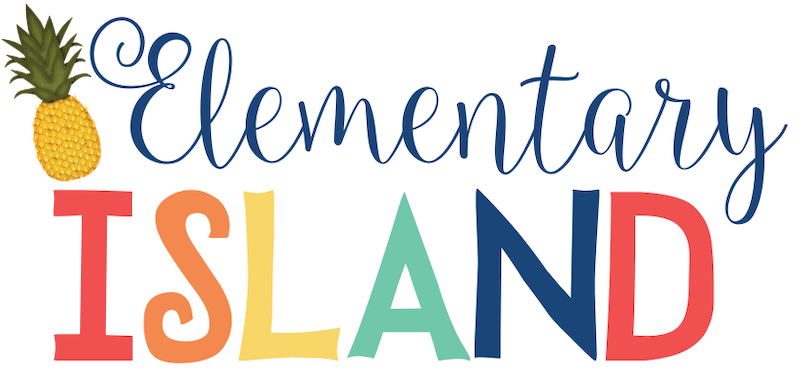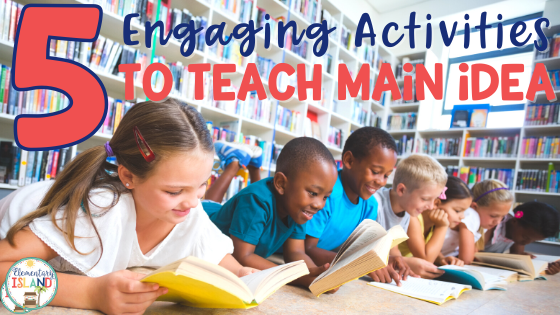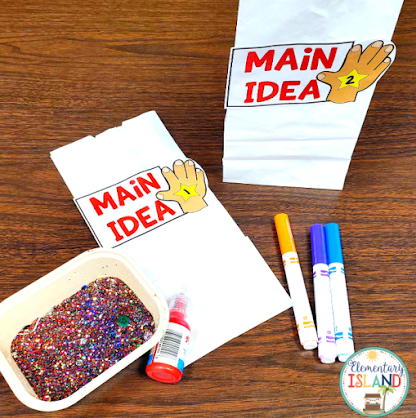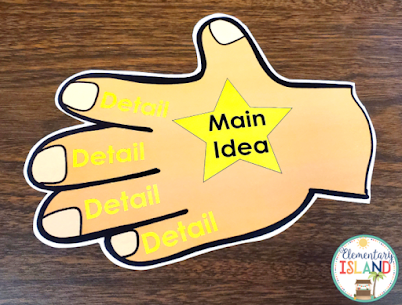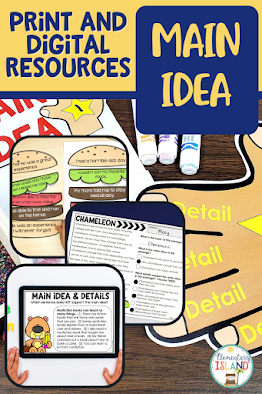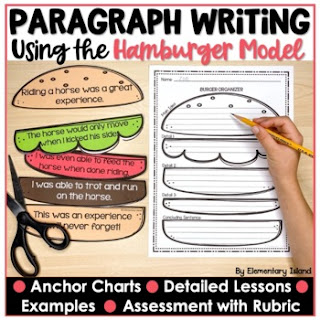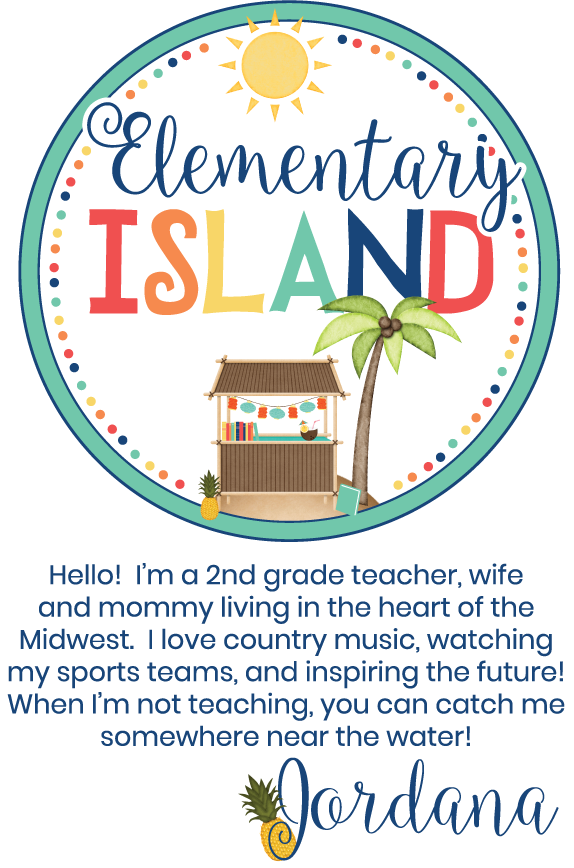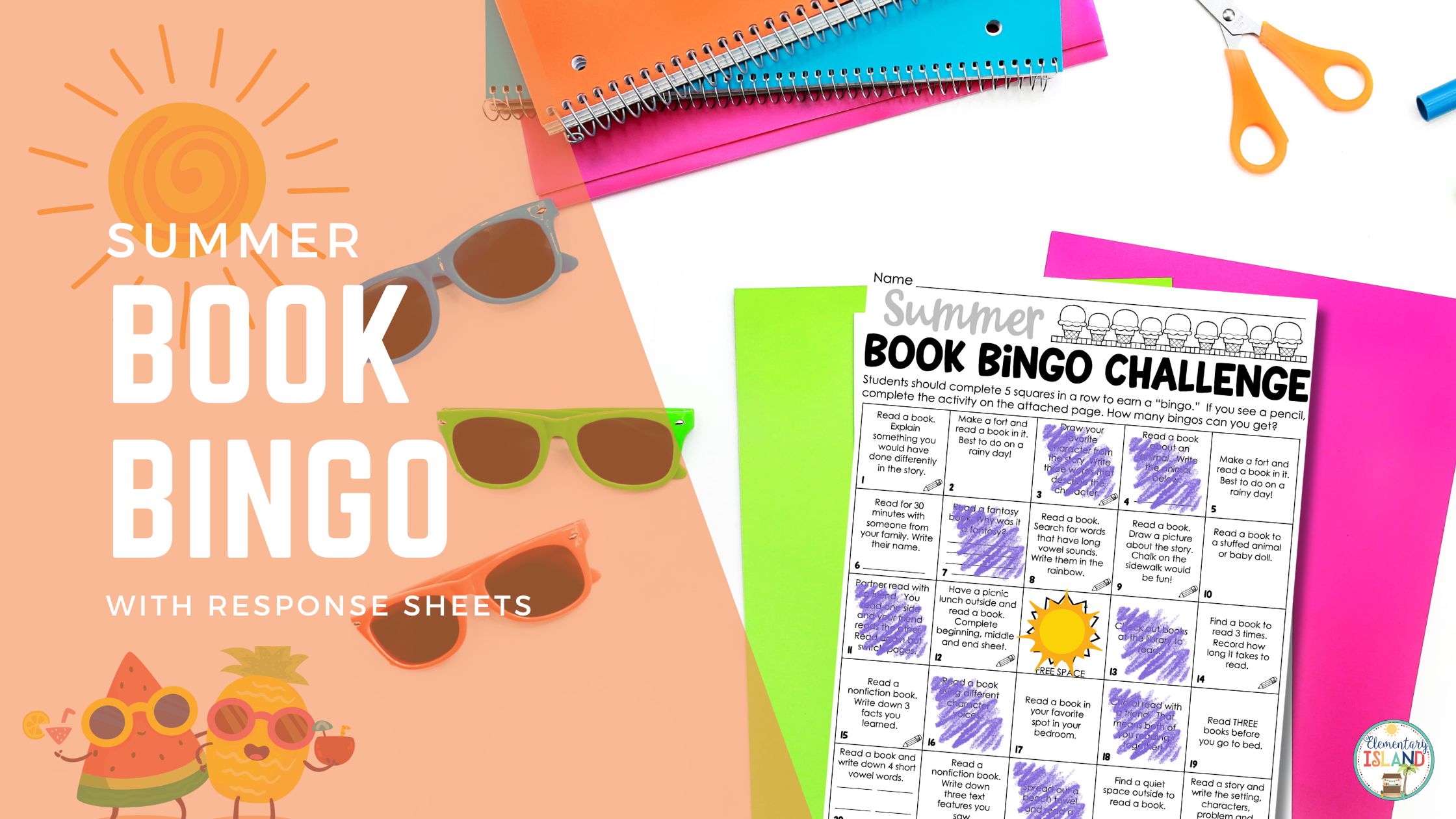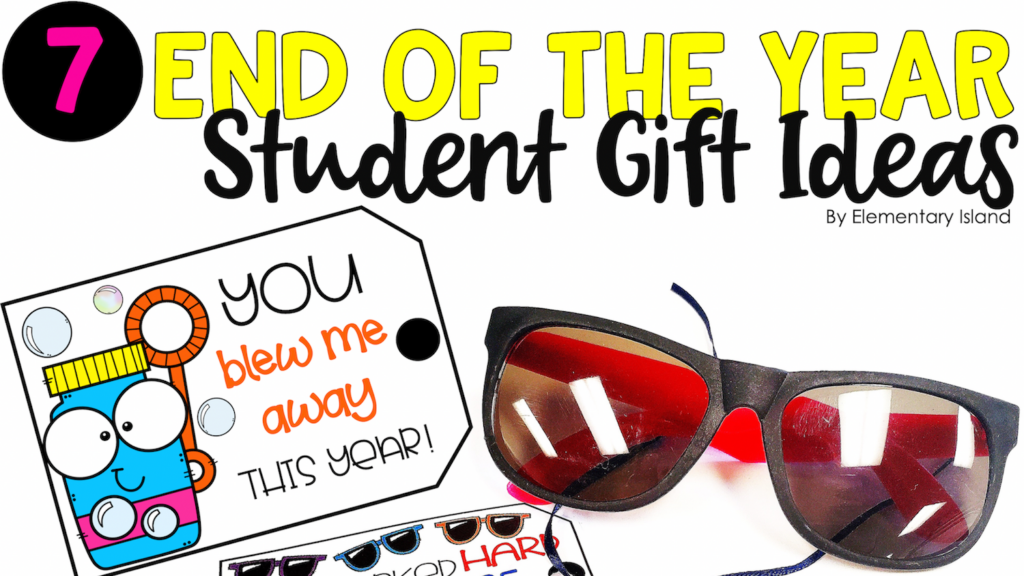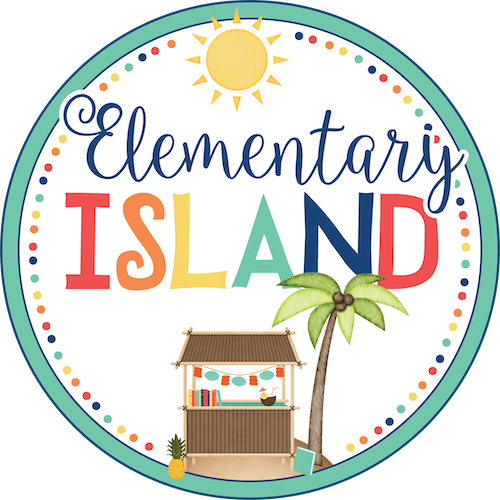Teaching main idea to your students doesn’t have to be a challenging or frustrating experience. With a little creative thinking and a few fun activities, your students will be on their way to mastering this important reading comprehension skill. We all know that learning to find the main idea is a concept that can be difficult for students to grasp. Over the years I’ve found some activities that have really helped my students and I’m excited to share those with you. Here’s 5 of my favorite engaging activities for teaching main idea.
5 Engaging Ways To Teach Main Idea

Over the years I’ve tried a lot of different activities and resources for teaching main idea. Some worked well and some . . . well, not so much. So I thought I’d share with you my favorite activities so you can focus your time and energy there and hopefully avoid the activities that didn’t work.
Like most concepts for our young students, it is important to begin with concrete activities that students can connect to in order to learn these important thinking skills.
Teaching a thinking process can be difficult and abstract. So start with the concrete and slowly move to more abstract activities. And make sure to build in lots of practice time. After all, repetition is the key to learning.
1. Main Idea Bag
This is such a fun hands-on activity and a really great way to introduce the concept of main idea to students. The first time we do the main idea bags, I prepare the bags. In each bag I put three items that are related by their theme or activity. There is nothing on the bag to indicate what is inside or how the contents of the bag relate. That’s up to the students to figure out.
We start by grabbing the first bag and pulling the items out one at a time. Each time I pull out an item, the students tell me what it is. Then I set the item up at the front of the room so everyone can see. We do this for each of the items. Once all three items I have been pulled out I ask the students some questions:
- What do these items have in common?
- What activity could I do with all of these items?
- What do you think the Main Idea of this bag is?
Those guiding questions are really important because they teach the students some of the thinking steps that will lead them to the main idea. We repeat this activity with another bag and the kids can’t wait to find out what is inside.
Once I feel like the students have a good grasp on the activity, we divide up into small groups and each group gets a bag. I usually prepare 6-8 bags total for this activity. That gives us 1-2 bags to do together as a class and the remaining bags to use as guided practice.
Each small group will go through the same process on their own. After they are done they put everything back in the bag and the group gets a new bag. The students love trying to figure out the main idea of each bag and they get really quiet and secretive so they don’t give away answers to other groups.
Then I issue the BIG ASSIGNMENT and the kids usually cheer! Each student is tasked with creating their own main idea bag at home. They creating their own bags and sharing them with the class. Having students create their own main idea bag is a great way for students to connect objects together using critical thinking strategies to determine how they are related.
This activity is loved so much that I’ve been known to repeat it at different times in the year. Depending on when we are doing this activity, I like to make the items in the bag correlate to a holiday, season, or classroom theme. If I am doing this activity in the spring, I may fill my bag with items such as flowers, a trowel, flower seeds, or a plastic baggie of soil.
2. The Main Idea Hand
Once students have an understanding of how to determine the main idea, it is time to add in the concept of supporting details. There are many different visuals you can use for this. One of my favorite is the Main Idea Hand. The Main Idea Hand is a graphic organizer that stays with students forever!
I start the activity by asking students to trace their hands on a colorful piece of construction paper and cut them out. Many times I don’t even tell them why we are doing this. This gets them really curious and they can’t wait to find out what the hand is for.
I let the students know that the hand, be it on paper or the one attached to their body, can be a great help when determining the main idea and supporting details.
I have all the students look at their hand – the physical one. I have them draw a circle on their palm and I tell them that this is the main idea. It’s the part that holds the rest of the hand together. Everything that connects to the palm of the hand has to relate to the hand.
To make my point, I get a little silly. I ask my students, “Who has a toe connected to their hand? What about an eyeball or an ear?” Nope! That’s because those things don’t relate to the palm of the hand. I like to remind them about the main idea bags and how each item related to each other.

Then we talk about how it is the details that actually lead to the main idea. I tell the students that each finger is a detail. To check the main idea we look at the details to see if they support the main idea. As we walk through some examples in class I like to hold my hand out to the class and touch each finger while saying the detail. Then I ask the students if it relates to or supports the main idea. If the answer is yes, I fold that finger in towards my palm. By doing this I create a thumbs up visual at the end that students can use as a check. No thumbs up? Not the main idea. Fingers still sticking out? Not supporting details.
What has been great about this activity is that I have seen students use it again and again as they work independently on reading comprehension activities. There’s nothing more rewarding than seeing a student touch their palm and fold their fingers in while doing a reading passage. What that tells me is that I’ve taught them a strategy that they remember and can use. I’ve even had a teacher from a higher grade level come and ask me about the hand after having some of my old students use it in her class.
Once we have learned about the main idea hand, we use that construction paper hand to create a visual reminder. Students will label the palm of the hand (main idea) and the fingers (supporting details). When we are done we add them to our reading notebooks.
This visual also goes up in our classroom on our reading strategies wall. It’s a constant reminder of tools students have learned to help them be successful with reading comprehension.
3. Main Idea and Mentor Texts
Even BEFORE I introduce main idea into the classroom, like many skills, I love using mentor texts. Not only do students get engrossed in read alouds, but it offers multiple opportunities to model reading and thinking skills. Here are some of my favorite books to use as mentor texts for teaching main idea.
Each of these books provides not only a great story, but also a unique opportunity to talk about main idea in a longer text. This is a great way to introduce main idea early in the year before you even begin studying it because then they will be familiar with the language.
For older students, the main idea is often the title of the chapters. So read a few chapters out loud and see if your students can come up with the main idea of each part!
4. Practice, Practice, Practice
 By now, students are generally ready to start applying the idea of main idea and supporting details to text. Like any skill, we always start together and I model the thinking and actions as we complete an activity. Sometimes this takes 1 passage on 1 day, and other times it takes a week of guided practice. It’s really important to trust your teacher gut and do what your students need. Don’t rush the process of moving them to independence too quickly. It will pay off in the long run.
By now, students are generally ready to start applying the idea of main idea and supporting details to text. Like any skill, we always start together and I model the thinking and actions as we complete an activity. Sometimes this takes 1 passage on 1 day, and other times it takes a week of guided practice. It’s really important to trust your teacher gut and do what your students need. Don’t rush the process of moving them to independence too quickly. It will pay off in the long run.
If most of your class is ready to work independently, then I add this skill to my small group reading instruction. This way I can continue to work with those students that need a little extra guided practice without holding up the entire class.
Here’s some of my favorite main idea and supporting detail practice activities. All of these have been used and approved by students!
A-Z Animals: Reading Passages For Main Idea And Supporting Details
If there is one thing that kids everywhere love it is animals. So it seemed like a no-brainer to use animals to engage students in this important skills practice. These non-fiction passages are designed to be used specifically for finding the main idea and supporting details. So often this skill gets lumped in with a large reading passage and one question on main idea. In my experience this is just not enough. These skill-specific passages really help students master identifying the main idea and supporting details.

After reading the short passage, students are guided through the thinking process by first starting with the topic. This is the easiest thing for students to identify. Next, we talk about what the passage is mostly about. Before we write anything down, we look to see if we can find details in the passage to support our main idea hypothesis. I like to have students underline or highlight their passages so they can visually see the key sentences in the passage.
Once identifying those details, we add them into the boxes at the bottom of the page. Then we go back to our main idea hypothesis so we can check it. During guided practice I will often hold my hand as we check our idea. If we end up with a thumbs up, we write our main idea into the box.
Over the next few days we will do more daily practice with main idea and supporting details. Once I feel like students are doing well with the concept, we continue to practice, but the activities are moved into centers, morning work and homework.


Finding the main idea while learning fun facts about some of our favorite animals is a great way to engage students in this skill. Each A-Z Animal Reading Passage includes two options for completing the activity. One option includes a multiple choice question and answers section for students to choose the main idea and supporting details. The second option includes the passage and sections for students to write the topic, main idea, and three supporting details from the passage. This makes scaffolding instruction and differentiating quick and easy.
Get DIGITAL with Main Idea and Supporting Details Boom Cards
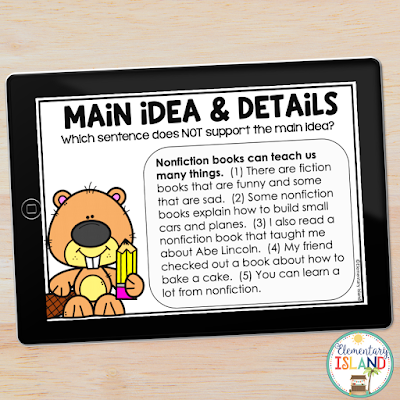
Another class favorite activity that my students absolutely love is
Main Idea and Supporting Details Boom Cards! Boom Cards are interactive and self-checking digital task cards that can be used on computers, laptops, and tablets. This NO PREP activity is a fantastic resource for me to use with my students because I can assign them a deck to use during independent learning time or literacy centers.
I use the Main Idea and Supporting Details Boom Cards to give some differentiated practice to my students. I love that these main idea activities continue to build student thinking skills for this reading concept. These Boom Card activities have students finding the main idea and supporting details in different ways. One variation asks students to read a paragraph and choose the correct sentence for the topic sentence from a list below the passage. The second variation asks students to read a paragraph and choose which sentence does NOT belong in the paragraph as a supporting detail. This is a great way for students to think about the paragraph as a whole and not in isolation.
The
Main Idea and Supporting Details Boom Cards are a great way to help students review what they have learned or give extra practice to those students who need it. They make a great reading center and a great way to engage students with technology.
5. Connecting Main Idea to Writing

The final step in our main idea journey is connecting the idea of main idea and supporting details to writing. Once students have a good understanding of this concept they are then able to begin applying it in their writing. By the time we get to this point it’s like we’ve come full circle!
The
Hamburger Paragraph Model is my absolute favorite and most effective way to teach paragraph writing! It is such a wonderful visual way to teach students how the pieces make the whole and it connects very easily to the idea of main idea and supporting details. It’s easy for students to see how everything will come together in the end to make the most effective paragraph possible.
When we use the parts of a hamburger to visualize the main idea, supporting details, and concluding sentences, our students are able to visually see how it all makes sense. Guiding my students through the process of creating the Hamburger Model has been a super successful approach to connecting main idea to writing.
Try It Out For Free
Ready to get started? I have put together some of these activities so that you can try them with your class. Grab this Free Main Idea packet and get everything you need to create the Main Idea Bag, the Main Idea Hand Visual and some A-Z Animals Main Idea Reading Passages to try out with your students. I know you and your students will love these activities as much as my students and I do!
If you are ready to jump in and use these resources with your students you can find the complete resource in my Teachers Pay Teachers store. Just click on the image below for each of these engaging main idea activities.
Save these Main Idea Teaching Ideas
Whether you need them now or for the future – save these fun and engaging activities for teaching main idea. Pin this to your favorite classroom Pinterest board so you can quickly come back when it is time to teach main idea to your students.
 Over the years I’ve tried a lot of different activities and resources for teaching main idea. Some worked well and some . . . well, not so much. So I thought I’d share with you my favorite activities so you can focus your time and energy there and hopefully avoid the activities that didn’t work.
Over the years I’ve tried a lot of different activities and resources for teaching main idea. Some worked well and some . . . well, not so much. So I thought I’d share with you my favorite activities so you can focus your time and energy there and hopefully avoid the activities that didn’t work. Then we talk about how it is the details that actually lead to the main idea. I tell the students that each finger is a detail. To check the main idea we look at the details to see if they support the main idea. As we walk through some examples in class I like to hold my hand out to the class and touch each finger while saying the detail. Then I ask the students if it relates to or supports the main idea. If the answer is yes, I fold that finger in towards my palm. By doing this I create a thumbs up visual at the end that students can use as a check. No thumbs up? Not the main idea. Fingers still sticking out? Not supporting details.
Then we talk about how it is the details that actually lead to the main idea. I tell the students that each finger is a detail. To check the main idea we look at the details to see if they support the main idea. As we walk through some examples in class I like to hold my hand out to the class and touch each finger while saying the detail. Then I ask the students if it relates to or supports the main idea. If the answer is yes, I fold that finger in towards my palm. By doing this I create a thumbs up visual at the end that students can use as a check. No thumbs up? Not the main idea. Fingers still sticking out? Not supporting details. By now, students are generally ready to start applying the idea of main idea and supporting details to text. Like any skill, we always start together and I model the thinking and actions as we complete an activity. Sometimes this takes 1 passage on 1 day, and other times it takes a week of guided practice. It’s really important to trust your teacher gut and do what your students need. Don’t rush the process of moving them to independence too quickly. It will pay off in the long run.
By now, students are generally ready to start applying the idea of main idea and supporting details to text. Like any skill, we always start together and I model the thinking and actions as we complete an activity. Sometimes this takes 1 passage on 1 day, and other times it takes a week of guided practice. It’s really important to trust your teacher gut and do what your students need. Don’t rush the process of moving them to independence too quickly. It will pay off in the long run. After reading the short passage, students are guided through the thinking process by first starting with the topic. This is the easiest thing for students to identify. Next, we talk about what the passage is mostly about. Before we write anything down, we look to see if we can find details in the passage to support our main idea hypothesis. I like to have students underline or highlight their passages so they can visually see the key sentences in the passage.
After reading the short passage, students are guided through the thinking process by first starting with the topic. This is the easiest thing for students to identify. Next, we talk about what the passage is mostly about. Before we write anything down, we look to see if we can find details in the passage to support our main idea hypothesis. I like to have students underline or highlight their passages so they can visually see the key sentences in the passage. 
 Another class favorite activity that my students absolutely love is Main Idea and Supporting Details Boom Cards! Boom Cards are interactive and self-checking digital task cards that can be used on computers, laptops, and tablets. This NO PREP activity is a fantastic resource for me to use with my students because I can assign them a deck to use during independent learning time or literacy centers.
Another class favorite activity that my students absolutely love is Main Idea and Supporting Details Boom Cards! Boom Cards are interactive and self-checking digital task cards that can be used on computers, laptops, and tablets. This NO PREP activity is a fantastic resource for me to use with my students because I can assign them a deck to use during independent learning time or literacy centers.  The final step in our main idea journey is connecting the idea of main idea and supporting details to writing. Once students have a good understanding of this concept they are then able to begin applying it in their writing. By the time we get to this point it’s like we’ve come full circle!
The final step in our main idea journey is connecting the idea of main idea and supporting details to writing. Once students have a good understanding of this concept they are then able to begin applying it in their writing. By the time we get to this point it’s like we’ve come full circle!